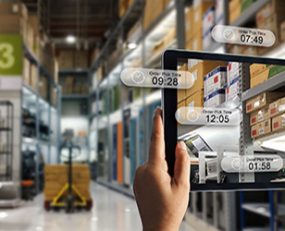
Augmented Reality (AR) is a growing industry which has been fuelled by the COVID pandemic. Research by Research and Market in 2021 found that the total AR market was valued at $14.7bn in 2020 and is projected to reach $88.4bn by 2026; it is expected to grow at a CAGR of 31.5% from 2021 to 2026.
Within logistics, AR has been increasingly utilised by logistics companies over the past few years, as logistics companies look to make operations more efficient and cost-effective. AR such as head-mounted displays and smart glasses are increasingly making appearances in the warehouses of third-party logistics companies. These AR tools can give workers crucial insights such as which directions to take to get to the designated item required, or hands-free barcode scanning to ensure order picking is accurate. AR can even aid warehouse technicians in detecting, diagnosing, and solving issues with machinery before a catastrophic failure occurs.
Two examples of successful AR utilisation include Coca Cola HBC and DHL. In its distribution centre based in Thessaloniki Greece, Coca-Cola HBC has utilised the TeamViewer solution xPick running on RealWear HMT-1 smart glasses since 2019. The glasses are used by the company’s warehouse employees, which are used in conjunction with the Coca-Cola HBC SAP production system and warehouse management system to deliver order data to customers. After two months of the vision picking implementation, Coca-Cola HB reported that the picking performance saw increases of approximately 6-8% total accuracy; picking accuracy with the use of smart glasses reaching 99.9%.
Similarly, DHL reported in 2022 that it had begun using smart glasses AR in its warehouses. DHL dubbed the process ‘Vision Picking’ and reported that it has seen a 15% increase in productivity and better accuracy. The Vision Picking pilot originally took place in a DHL warehouse in the Netherlands, before DHL announced in 2020 that it had successfully standardised the solution internationally.
DHL doesn’t only use AR for Vision Picking. Other functions of the smart glasses for DHL include logistics infrastructure design and immersive training. According to DHL, AR enables more efficient logistics infrastructure design by allowing workers to simulate infrastructure layout planning and equipment operation through DHL logistics operations, which saves costs by allowing experimentation through AR without the need to spend additional resources on creating new designs. Similarly, immersive training in AR allows for new workers to be trained for DHL warehouse systems, such as practical training on operating forklifts, without interrupting real-world warehouse operations during training, therefore saving costs by avoiding disruption to operations.
Within the Express market, use of AR can be found in the operations of providers such as Royal Mail and Hermes, which both have implemented AR parcel sizing in 2019. This allows customers to use the Royal Mail or Hermes app with their phones to size their parcels and see the price for sending their parcel. This then removes the need for customers to enter post offices, as the postage purchase can be made through the app.
As big providers continue to commit mass sums of money to innovation and technology, AR has potential to continue to transform the way that logistics operations are undertaken. With e-commerce continuing to flourish, and logistics providers increasingly needing to implement automated processes to deal with smaller consignments, quicker delivery, and a mix of fast and slow-moving SKUs, we may expect to see the logistics industry continue implementing technology such as AR on a large scale.
However, AR faces some challenges to see its potential fully reached, such as the semiconductor shortage increasing the costs of electronics. AR is also not seen very favourable by all providers; for example, in a survey conducted by JLL in 2021 by 720 logistics experts on the future of global logistics, JLL found that other technologies were seen as more likely to change global logistics than AR. Other technologies seen as being more likely to impact global logistics were: automation and robotics, internet of things, 5G, and autonomous transport. The future of AR is unclear, but its potential has yet to be fully realised within logistics.
Source: Transport Intelligence, May 26, 2022
Author: Michael Sinclair